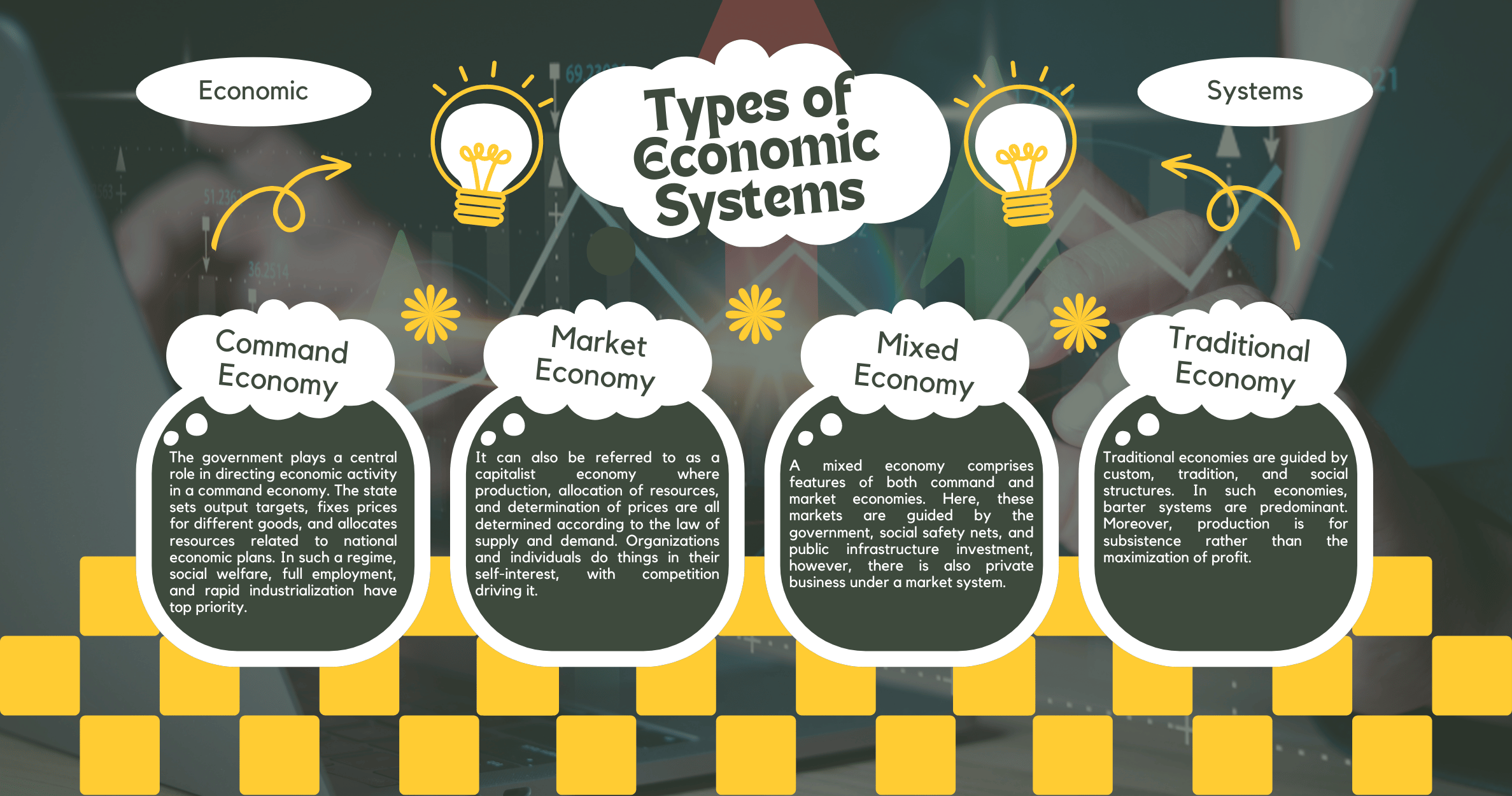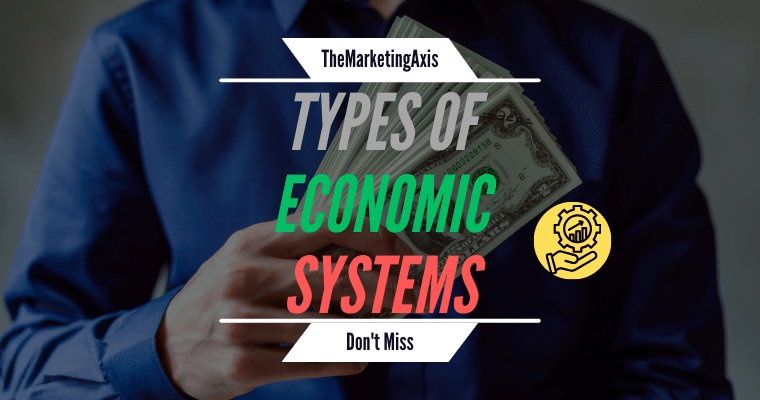An economic system is normally defined as how societies organize production and the distribution of goods and services, and how the allocation of resources is carried out within societies. These systems influence everything from the choices in everyday life to international trade. Understanding the different types of economic systems that exist is important in appreciating the diversity of the economic structures in the world and their impact on individuals and societies. This article gives an overview of four types of economic systems as follows:
Types of Economic Systems:
- Command Economy
- Market Economy
- Mixed Economy
- Traditional Economy
Here are the Characteristics, advantages, and disadvantages of each type of economic system with practical examples.

1. Command Economy (Planned Economy)
The government plays a central role in directing economic activity in a command economy. The state sets output targets, fixes prices for different goods, and allocates resources related to national economic plans. In such a regime, social welfare, full employment, and rapid industrialization have top priority.
Characteristics:
- Centralized Planning: Centralized planning by the government dictates levels of production, quantities of resources to be used, and prices of goods and services.
- State ownership: All the key sectors of industry and business are owned and managed by the state.
- Limited role for markets: Prices are centrally determined; markets do not play any significant role in allocating resources.
- Social objectives: This is where the government focuses on matters concerning the welfare of society and developmental issues within a country.
Advantages:
- Rapid economic growth: Centralized planning paves the way for rapid industrialization and economic development in the initial stages.
- Resource Allocation for Social Programs: Resources can be channeled towards social welfare programs in health and education.
- Less income inequality: The distribution of income can be much more even under government pursuit.
Disadvantages:
- Limited choice to consumers: Very few options are available to consumers since production is concentrated on goods centrally planned.
- Lack of innovativeness: With the reduced competition in the market, there would be less concern about innovation and the advancement of technology.
- Inefficiency: Centralized decision-making can be slow and ineffective. For instance, this might cause a deficit or surplus of goods in the market.
Examples: Former Soviet Union, Cuba, North Korea (with varying degrees of implementation)
2. Market Economy
It can also be referred to as a capitalist economy where production, allocation of resources, and determination of prices are all determined according to the law of supply and demand. Organizations and individuals do things in their self-interest, with competition driving it.
Characteristics:
- Private Ownership: Private ownership simply implies that the majority of businesses and resources are owned by private individuals or entities.
- Freedom of choice: More freedom will exist for both the consumer and firms while making economic decisions.
- Profit motive: A business operates for profits; this in itself introduces an element of incentive for innovation and efficiency.
- Role of markets: Prices are determined due to the supply of markets and the demand for goods.
Advantages:
- Efficiency and innovation: It boosts efficiency and innovation since it is through this competition that, in response, businesses try to be efficient and innovate to attract customers.
- Wider variety of goods and services: Market forces cater to diverse consumer preferences, hence there is a wider variety of products and services.
- Economic Growth: The drive for profit can stimulate economic growth and the creation of jobs.
Disadvantages:
- Income inequality: It can further lead to the concentration of wealth in a few hands and hence social inequality.
- Limited social welfare programs: The market does not guarantee provisions for social welfare, which might need the intervention of the government.
- Boom-and-bust cycles: Market economies may allow boom-and-bust cycles to take place.
Examples: United States, Canada, most Western European nations
3. Mixed Economy
A mixed economy comprises features of both command and market economies. Here, these markets are guided by the government, social safety nets, and public infrastructure investment, however, there is also private business under a market system.
Characteristics:
- Public-private mix: The government interferes in the market to various degrees, although private enterprises play a large role.
- Market regulation: The government sets regulations to protect the consumer against exploitation, to promote competition for survival or business, and to give stability to the market.
- Social Safety Nets: The majority of the governments usually provide social programs including unemployment benefits and health care.
Advantages:
- Economic Growth: Markets may be pro-growth, but government intervention can ensure that social concerns are addressed and stability is guaranteed.
- Consumer choice and innovation: Choice at the consumer level, markets do provide for this; innovation, however, in certain sectors can be better dealt with by state intervention.
- Social welfare programs: The programs provide a safety net for those at risk.
Disadvantages:
- Finding the Right Balance: Balancing between market forces and government intervention can often be very tough.
- Inefficiency of government: Government inefficiency can retard economic growth.
Examples: Most developed economies today have elements of a mixed economy, with varying degrees of government intervention.
4. Traditional Economy
Traditional economies are guided by custom, tradition, and social structures. In such economies, barter systems are predominant. Moreover, production is for subsistence rather than the maximization of profit.
Characteristics:
- Traditional practices: The state of economic activities is stipulated by passed practices and social norms.
- Subsistence living: Production is taken into consideration in the fulfillment of basic needs within the community or family circle.
- Limited role of markets: There may be systems of barter or informal markets, although more formal market structures are often lacking.
- Strong social bonds: Strong social bonds are exemplified in cooperation and social responsibility as core values within traditional economies.
Advantages:
- Strong social cohesion: Traditional economies often promote a strong social bond and sense of community.
- Environmental Sustainability: Traditional practices may more count on sustainable resource utilization
Disadvantages:
- Limited economic growth: Traditional economies can record very little consequential growth in their economies; this is explained by the fact that there are very slight innovations and market structures.
- Extrinsic vulnerability: Nut cases can expose traditional economies to risks, ranging from natural disasters to changes in trading patterns.
Examples: Certain Indigenous communities, some remote rural societies
Choosing the Right System: A Complex Issue
There exists no one “best” sort of economic system. The best for any given country depends on the level of development, cultural values, and political stability needed, among other factors. Success for the mixed economic system usually comes in developed nations, though in many ways there has been much interference by government policies to face market forces and create growth and social welfare.
You can also Read: Stock Market: The Backbone of the Economy
The Importance of Economic Systems in Today’s World
Understanding different economic systems allows us to:
- Bring out global economic diversity: The world is not a homogenous place economically. Understanding the fact that there are different systems allows one, besides anything else, to have a more sophisticated realization of the phenomena of world trade and international relations.
- Evaluate economic policies: Using the knowledge of the strengths and weaknesses of various economic models, we assess the potential influence of alternative policy choices.
- Promote informed decision-making: Citizens get empowered when economic systems are known. This enables them to have an informed discussion on the economic policies and potential impacts.
Frequently Asked Questions (FAQ’s)
1. What are the main types of economic systems?
The four main types of economic systems are:
- Command Economy (Planned Economy
- Market Economy (Capitalist Economy)
- Mixed Economy
- Traditional Economy
2. What is the best economic system?
No one of any system is widely regarded as the “best” system for any nation. However, this depends on factors such as the level of development, cultural values, and political stability. Likewise, developed nations tend towards mixed economies that balance market-based forces with government intervention for growth and social welfare.
3. What are the advantages and disadvantages of a market economy?
The advantages and disadvantages of a market economy are as follows:
Advantages:
- Efficiency and innovation: Business competition forces firms to be efficient in all processes of production. This makes them innovative, therefore, introducing new products to lure customers.
- Wider variety of goods and services: Market forces cater to diverse consumer preferences.
- Economic growth: It is the drive for profitable benefits that might fuel economic growth as well as create employment.
Disadvantages:
- Income inequality: Accumulation of wealth by only a few people eventually leads to social inequality.
- Social welfare programs are limited: The government takes steps to ensure that all social welfare under the market is optimal and guaranteed, rather than providing only some provisions.
- Boom-and-bust cycles: Economic cycles, with high growth followed by downturn phases, are a characteristic of market economies.
4. What is the role of government in a mixed economy?
In a mixed economy, the government plays several roles:
- Regulation: Establish regulations in a way that guarantees safety to the consumer, ensures competition, and that the market is.
- Social Programs: Provide unemployment benefits, health care, and so on.
- Public infrastructure investment: Invest in the reinvestment into infrastructures such as roads, and bridges to support the economic activity.
5. What are some examples of different economic systems in the world today?
Some examples of different economic systems in the world today are as follows:
- Command Economy: North Korea (inefficiently realized)
- Market Economy: United States, Canada
- Mixed Economy: Most developed economies today have the element of a mixed economy, albeit to the various degrees of government intervention (e.g., Germany, China)
- Traditional Economy: Primarily of indigenous communities and remote rural societies.




